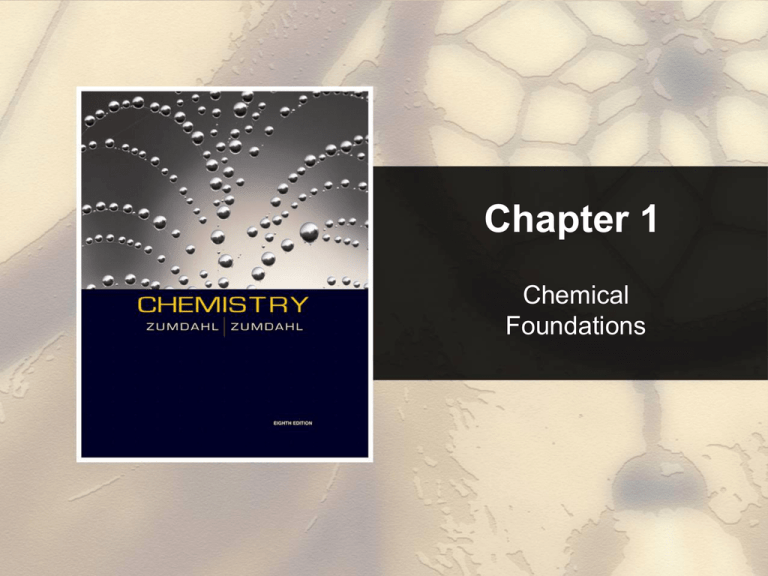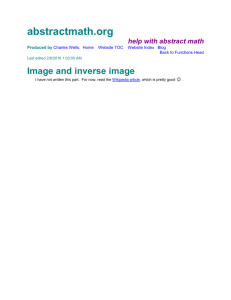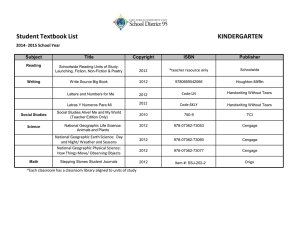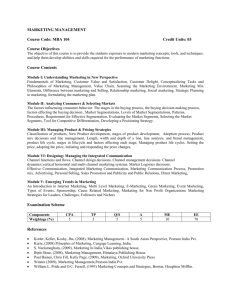
Chapter 1
Chemical
Foundations
Chapter 1
Table of Contents
1.1
1.2
1.3
1.4
1.5
1.6
1.7
1.8
1.9
Chemistry: An Overview
The Scientific Method
Units of Measurement
Uncertainty in Measurement
Significant Figures and Calculations
Dimensional Analysis
Temperature
Density
Classification of Matter
Return to TOC
Copyright © Cengage Learning. All rights reserved
Section 1.1
Chemistry: An Overview
•
•
A main challenge of chemistry is to understand
the connection between the macroscopic world
that we experience and the microscopic world
of atoms and molecules.
You must learn to think on the atomic level.
Return to TOC
Copyright © Cengage Learning. All rights reserved
Section 1.1
Chemistry: An Overview
Atoms vs. Molecules
• Matter is composed of tiny particles called atoms.
• Atom: smallest part of an element that is still that element.
• Molecule: Two or more atoms joined and acting as a unit.
Return to TOC
Copyright © Cengage Learning. All rights reserved
Section 1.1
Chemistry: An Overview
Oxygen and Hydrogen Molecules
• Use subscripts when more than one atom is in the
molecule.
Return to TOC
Copyright © Cengage Learning. All rights reserved
Section 1.1
Chemistry: An Overview
A Chemical Reaction
• One substance changes to another by reorganizing the
way the atoms are attached to each other.
Return to TOC
Copyright © Cengage Learning. All rights reserved
Section 1.2
The Scientific Method
Science
•
Science is a framework for gaining and
organizing knowledge.
• Science is a plan of action — a procedure for
processing and understanding certain types of
information.
• Scientists are always challenging our current
beliefs about science, asking questions, and
experimenting to gain new knowledge.
– Scientific method is needed.
Return to TOC
Copyright © Cengage Learning. All rights reserved
Section 1.2
The Scientific Method
Fundamental Steps of the Scientific Method
• Process that lies at
the center of scientific
inquiry.
Return to TOC
Copyright © Cengage Learning. All rights reserved
Section 1.2
The Scientific Method
Scientific Models
Law
• Summarizes what happens.
Hypothesis
• A possible explanation for an observation.
Theory (Model)
• An attempt to explain why it happens.
• Set of tested hypotheses that gives an overall
explanation of some natural phenomenon.
Copyright © Cengage Learning. All rights reserved
Return to TOC
Section 1.3
Units of Measurement
Nature of Measurement
Measurement
•
Quantitative observation consisting of two parts.
number
scale (unit)
•
Examples
20 grams
6.63 × 10–34 joule·seconds
Return to TOC
Copyright © Cengage Learning. All rights reserved
Section 1.3
Units of Measurement
The Fundamental SI Units
Physical Quantity
Mass
Length
Time
Temperature
Electric current
Amount of substance
Name of Unit
kilogram
meter
second
kelvin
ampere
mole
Abbreviation
kg
m
s
K
A
mol
Return to TOC
Copyright © Cengage Learning. All rights reserved
Section 1.3
Units of Measurement
Prefixes Used in the SI System
•
Prefixes are used to change the size of the unit.
Return to TOC
Copyright © Cengage Learning. All rights reserved
Section 1.3
Units of Measurement
Prefixes Used in the SI System
Return to TOC
Copyright © Cengage Learning. All rights reserved
Section 1.4
Uncertainty in Measurement
•
•
•
A digit that must be estimated is called
uncertain.
A measurement always has some degree of
uncertainty.
Record the certain digits and the first uncertain
digit (the estimated number).
Return to TOC
Copyright © Cengage Learning. All rights reserved
Section 1.4
Uncertainty in Measurement
Measurement of Volume Using a Buret
• The volume is read at the bottom of
the liquid curve (meniscus).
• Meniscus of the liquid occurs at
about 20.15 mL.
Certain digits: 20.15
Uncertain digit: 20.15
Return to TOC
Copyright © Cengage Learning. All rights reserved
Section 1.4
Uncertainty in Measurement
Precision and Accuracy
Accuracy
•
Agreement of a particular value with the true value.
Precision
•
Degree of agreement among several measurements
of the same quantity.
Return to TOC
Copyright © Cengage Learning. All rights reserved
Section 1.4
Uncertainty in Measurement
Precision and Accuracy
Return to TOC
Copyright © Cengage Learning. All rights reserved
Section 1.5
Significant Figures and Calculations
Rules for Counting Significant Figures
1. Nonzero integers always count as significant
figures.
3456 has 4 sig figs (significant figures).
Return to TOC
Copyright © Cengage Learning. All rights reserved
Section 1.5
Significant Figures and Calculations
Rules for Counting Significant Figures
• There are three classes of zeros.
a. Leading zeros are zeros that precede all the
nonzero digits. These do not count as
significant figures.
0.048 has 2 sig figs.
Return to TOC
Copyright © Cengage Learning. All rights reserved
Section 1.5
Significant Figures and Calculations
Rules for Counting Significant Figures
b. Captive zeros are zeros between nonzero
digits. These always count as significant
figures.
16.07 has 4 sig figs.
Return to TOC
Copyright © Cengage Learning. All rights reserved
Section 1.5
Significant Figures and Calculations
Rules for Counting Significant Figures
c. Trailing zeros are zeros at the right end of the
number. They are significant only if the number
contains a decimal point.
9.300 has 4 sig figs.
150 has 2 sig figs.
Return to TOC
Copyright © Cengage Learning. All rights reserved
Section 1.5
Significant Figures and Calculations
Rules for Counting Significant Figures
3. Exact numbers have an infinite number of
significant figures.
1 inch = 2.54 cm, exactly.
9 pencils (obtained by counting).
Return to TOC
Copyright © Cengage Learning. All rights reserved
Section 1.5
Significant Figures and Calculations
Exponential Notation
•
Example
•
300. written as 3.00 × 102
Contains three significant figures.
Two Advantages
Number of significant figures can be easily indicated.
Fewer zeros are needed to write a very large or very
small number.
Return to TOC
Copyright © Cengage Learning. All rights reserved
Section 1.5
Significant Figures and Calculations
Significant Figures in Mathematical Operations
1. For multiplication or division, the number of
significant figures in the result is the same as
the number in the least precise measurement
used in the calculation.
1.342 × 5.5 = 7.381 7.4
Return to TOC
Copyright © Cengage Learning. All rights reserved
Section 1.5
Significant Figures and Calculations
Significant Figures in Mathematical Operations
2. For addition or subtraction, the result has the
same number of decimal places as the least
precise measurement used in the calculation.
23.445
7.83
31.275
Corrected
31.28
Return to TOC
Copyright © Cengage Learning. All rights reserved
Section 1.5
Significant Figures and Calculations
Concept Check
You have water in each
graduated cylinder shown. You
then add both samples to a
beaker (assume that all of the
liquid is transferred).
How would you write the
number describing the total
volume?
3.1 mL
What limits the precision of the
total volume?
Return to TOC
Copyright © Cengage Learning. All rights reserved
Section 1.6
Dimensional Analysis
•
Use when converting a given result from one
system of units to another.
To convert from one unit to another, use the
equivalence statement that relates the two units.
Derive the appropriate unit factor by looking at the
direction of the required change (to cancel the
unwanted units).
Multiply the quantity to be converted by the unit
factor to give the quantity with the desired units.
Copyright © Cengage Learning. All rights reserved
Section 1.6
Dimensional Analysis
Example #1
A golfer putted a golf ball 6.8 ft across a green. How
many inches does this represent?
To convert from one unit to another, use the
equivalence statement that relates the two units.
1 ft = 12 in
The two unit factors are:
1 ft
12 in
and
12 in
1 ft
Copyright © Cengage Learning. All rights reserved
Section 1.6
Dimensional Analysis
Example #1
A golfer putted a golf ball 6.8 ft across a green. How
many inches does this represent?
•
Derive the appropriate unit factor by looking at the
direction of the required change (to cancel the
unwanted units).
12 in
6.8 ft
1 ft
Copyright © Cengage Learning. All rights reserved
in
Section 1.6
Dimensional Analysis
Example #1
A golfer putted a golf ball 6.8 ft across a green. How
many inches does this represent?
•
Multiply the quantity to be converted by the unit factor
to give the quantity with the desired units.
12 in
82 in
6.8 ft
1 ft
Copyright © Cengage Learning. All rights reserved
Section 1.6
Dimensional Analysis
Example #2
An iron sample has a mass of 4.50 lb. What is the
mass of this sample in grams?
(1 kg = 2.2046 lbs; 1 kg = 1000 g)
4.50 lbs
1 kg
1000 g
= 2.04 103 g
2.2046 lbs
1 kg
Copyright © Cengage Learning. All rights reserved
Section 1.6
Dimensional Analysis
Concept Check
What data would you need to estimate the
money you would spend on gasoline to drive
your car from New York to Los Angeles?
Provide estimates of values and a sample
calculation.
Copyright © Cengage Learning. All rights reserved
Section 1.7
Temperature
Three Systems for Measuring Temperature
•
•
•
Fahrenheit
Celsius
Kelvin
Return to TOC
Copyright © Cengage Learning. All rights reserved
Section 1.7
Temperature
The Three Major Temperature Scales
Return to TOC
Copyright © Cengage Learning. All rights reserved
Section 1.7
Temperature
Converting Between Scales
TK TC + 273.15
TC
5C
TF 32 F
9F
TC TK 273.15
9F
TF TC
+ 32 F
5C
Return to TOC
Copyright © Cengage Learning. All rights reserved
Section 1.7
Temperature
Exercise
At what temperature does C = F?
Return to TOC
Copyright © Cengage Learning. All rights reserved
Section 1.7
Temperature
Solution
•
•
Since °C equals °F, they both should be the same
value (designated as variable x).
Use one of the conversion equations such as:
TC
•
TF 32 F
5C
9F
Substitute in the value of x for both TC and TF. Solve
for x.
Return to TOC
Copyright © Cengage Learning. All rights reserved
Section 1.7
Temperature
Solution
TC
TF 32 F
x
5C
9F
x 32 F
5C
9F
x 40
So 40C = 40F
Return to TOC
Copyright © Cengage Learning. All rights reserved
Section 1.8
Density
•
•
Mass of substance per unit volume of the
substance.
Common units are g/cm3 or g/mL.
mass
Density =
volume
Return to TOC
Copyright © Cengage Learning. All rights reserved
Section 1.8
Density
Example #1
A certain mineral has a mass of 17.8 g and a volume of
2.35 cm3. What is the density of this mineral?
mass
Density =
volume
17.8 g
Density =
2.35 cm3
3
Density = 7.57 g/cm
Return to TOC
Copyright © Cengage Learning. All rights reserved
Section 1.8
Density
Example #2
What is the mass of a 49.6-mL sample of a liquid, which
has a density of 0.85 g/mL?
Density =
0.85 g/mL =
mass
volume
x
49.6 mL
mass = x = 42 g
Return to TOC
Copyright © Cengage Learning. All rights reserved
Section 1.9
Classification of Matter
Matter
•
•
Anything occupying space and having mass.
Matter exists in three states.
Solid
Liquid
Gas
Return to TOC
Copyright © Cengage Learning. All rights reserved
Section 1.9
Classification of Matter
The Three States of Water
Return to TOC
Copyright © Cengage Learning. All rights reserved
Section 1.9
Classification of Matter
Solid
•
•
Rigid
Has fixed volume and shape.
Return to TOC
Copyright © Cengage Learning. All rights reserved
Section 1.9
Classification of Matter
Structure of a Solid
Return to TOC
Copyright © Cengage Learning. All rights reserved
Section 1.9
Classification of Matter
Liquid
•
•
Has definite volume but no specific shape.
Assumes shape of container.
Return to TOC
Copyright © Cengage Learning. All rights reserved
Section 1.9
Classification of Matter
Structure of a Liquid
Return to TOC
Copyright © Cengage Learning. All rights reserved
Section 1.9
Classification of Matter
Gas
•
•
Has no fixed volume or shape.
Takes on the shape and volume of its
container.
Return to TOC
Copyright © Cengage Learning. All rights reserved
Section 1.9
Classification of Matter
Structure of a Gas
Return to TOC
Copyright © Cengage Learning. All rights reserved
Section 1.9
Classification of Matter
Mixtures
•
Have variable composition.
Homogeneous Mixture
Having visibly indistinguishable parts; solution.
Heterogeneous Mixture
Having visibly distinguishable parts.
Return to TOC
Copyright © Cengage Learning. All rights reserved
Section 1.9
Classification of Matter
Homogeneous Mixtures
Return to TOC
Copyright © Cengage Learning. All rights reserved
Section 1.9
Classification of Matter
Homogeneous vs. Heterogeneous Mixtures
Return to TOC
Copyright © Cengage Learning. All rights reserved
Section 1.9
Classification of Matter
Compound vs. Mixture
Return to TOC
Copyright © Cengage Learning. All rights reserved
Section 1.9
Classification of Matter
Concept Check
Which of the following is a homogeneous
mixture?
Pure water
Gasoline
Jar of jelly beans
Soil
Copper metal
Return to TOC
Copyright © Cengage Learning. All rights reserved
Section 1.9
Classification of Matter
Physical Change
•
Change in the form of a substance, not in its
chemical composition.
•
Example: boiling or freezing water
Can be used to separate a mixture into pure
compounds, but it will not break compounds
into elements.
Distillation
Filtration
Chromatography
Return to TOC
Copyright © Cengage Learning. All rights reserved
Section 1.9
Classification of Matter
Chemical Change
•
A given substance becomes a new substance
or substances with different properties and
different composition.
Example: Bunsen burner (methane reacts with
oxygen to form carbon dioxide and water)
Return to TOC
Copyright © Cengage Learning. All rights reserved
Section 1.9
Classification of Matter
The Organization of Matter
Return to TOC
Copyright © Cengage Learning. All rights reserved
Section 1.9
Classification of Matter
Concept Check
How many of the following are examples of a
chemical change?
Pulverizing (crushing) rock salt
Burning of wood
Dissolving of sugar in water
Melting a popsicle on a warm summer day
Return to TOC
Copyright © Cengage Learning. All rights reserved



